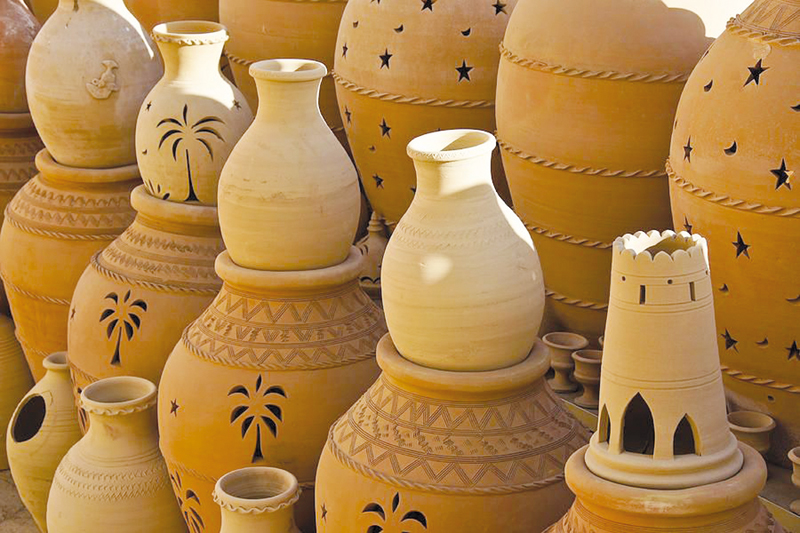

HOW about a home with a cozy coffee table decor or decorate with flowers and curios. Now, a home with a Middle Eastern influence is not far to seek. The Middle Eastern influences are a combination of ethnic mix and contemporary. The interior and décor is all about architectural mastery, heritage, contrast between luxury and simplicity, or designs giving a lasting impression.

The trends in home décor are a mix of spiced up traditional decorative patterns, native handicraft items, beautiful wooden carvings and decorative fabrics. Rachel Eapen, an Indian expatriate in Oman since 2012, has in depth knowledge about interiors and designs. As an amateur self-taught artist who chronicles about interiors, she provides useful tips which will help readers evolve a Middle Eastern décor with a contemporary feel.
Most of the homes in the Middle East focus on hospitality. Therefore, one can find huge living rooms (Majlis) and dining rooms with outdoor and indoor day beds or floor seating that seats at least eight people. She suggests beautiful rich coloured pillows on the floor seating and a low table top with a beautiful silver Arab tea set, traditional hookah pipe (Dalla) or the traditional Omani coffee pot. All these elements give emphasis on hospitality.

Arab furniture concentrates heavily on carved wooden pieces and beautifully carved doors which are geometrical and displays simple flower patterns and palm tree motifs. Traditional Omani chests made of wood, otherwise called ‘Mandoos’, can be displayed as a decorative piece. It is usually deep red in colour, engraved in gold, silver or brass and comes in different sizes. The huge ones are generally displayed in the hallway some convert it as a coffee table or can be kept at the end of the bed to store shawls and blankets.
In Muscat, it is easy to source a variety of décor items. The wooden chests are available in the traditional souqs in Muttrah and Nizwa.
As regards new trends, Rachel feels neutral colours with a pop of bright colours, or two-tone kitchen where one colour is neutral and the other bright seems to be in thing. Also bold colour sofas and geometric chairs, with display of large scale wall art creates a visually depth space with trends of minimalism.

Raw, rustic clay pots and beautifully glazed ones are equally displayed indoors and outdoors, not just with plants, but can be used as a decorative piece as well.
The best places to buy traditional pots are from souqs and from Bahla, the pottery town famous for producing clay pots.
At Nizwa souq one can buy beautiful pottery ranging from tiny oil burners, beautiful incense burners, and large water urns to decorative pots.
The use of beautiful stained glass doors and windows are used to bring natural day light which gives a charming feel to the space. Use of chandeliers is commonly used to give a luxurious effect giving a new dimension to the room. Traditional beautiful lanterns are used as well especially outdoors to give a magical and cozy atmosphere at night. She says one can use oil burners or the contemporary lanterns and hang it around the outdoor furniture or some corners of the home.
Rachel says the core design and patterns will continue to remain but will evolve differently. For example, the textiles made by Bedouin weavers will always remain the same, especially the geometrical designs and bright colours.
The colour palette generally followed in most of the rooms is earthy with liberal use of rich colours like gold, red, silver, ochers and orange. This can be achieved through bright rugs, upholstery, drapes, pillows and textured paint, giving a colourful and warm energy to the space. The walls can be adorned with framed paintings depicting Arab culture, wall tapestries and even framed traditional silver jewellery to showcase craftsmanship.
Omani dagger (Khanjar) can also be displayed as an art piece as it is considered as Oman’s pride in silver craftsmanship. The best place to buy the Khanjar and traditional silver jewellery is Muttrah souq and souvenir shops.
A passionate blogger, Rachel’s Muscat home has a strong middle-eastern influence in décor. She has incorporated floor cushions for seating, bright cushions for the sofa, pottery and a traditional hookah pipe for outdoors and some traditional silver décor accents. As one who always admired beautiful homes, both big and small, she offers tips on décor accessories which can give a different look to your workstation or coffee table.
Layers of luxurious weaves through heavy drapery, plush rugs, floor cushions, satin pillows, throws and tapestries are the key elements that give an opulent effect to the room. The use of fringes and tassels on curtains and cushions add another layer of richness.
The patterns used are generally geometric in nature and predominantly red, white and black in colour and lasts a lifetime. For selection of authentic traditional tapestries, rugs and runners, she suggests Oman Heritage Village near Nizwa souq as the right spot. Indoor plants are often added to homes which gives the feel of an oasis. But these plants must blend well with the furniture, patterns and designs that are used in each room.
Rachel loves global décor, eclectic design, a mix of boho or even Scandinavian style. If you want to get started, check out her blog at tickledbyinspirations.blogspot.com which will help redecorate your home. Finally, it’s all about the garden or a studio space getting an ethnic Middle Eastern touch.
Oman Observer is now on the WhatsApp channel. Click here



